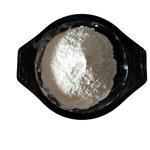β-Cyclodextrin (β-CD) is a cyclic oligosaccharide that contains seven D-(+)-glucopyranose units and has been used to improve the aqueous solubility of various compounds, especially those containing a phenyl group. The circular arrangement of its glucose units produces a torus-shaped ring configuration in which the CH2 groups and ether linkages of the molecule face the hollow interior, resulting in a nonpolar, hydrophobic cavity and a polar, hydrophilic exterior. When combined in solution with other compounds, the nonpolar aromatic portions of that compound interact with the nonpolar interior of the β-CD molecule, thus isolating the aromatic portion of the molecule from the water and thereby increasing its aqueous solubility.
beta-Cyclodextrin hydrate forms clathrates. Produces a water-soluble complex with dansyl chloride for the fluorescent labeling of proteins. It is used in pharmaceutical research, as pharmaceutical intermediates and also as chemical reagents.
β-cyclodextrin (β-CD), a well-known macrocyclic oligosaccharide member of the CD family, is composed of seven D-glucose units connected via α(1→4) glycosidic bonds. Its ability to form several inclusion complexes with organic as well as inorganic compounds makes it a potential candidate in solid and solution state determinations.
Recrystallise β-cyclodextrin from water and dry it for 12hours in a vacuum at 110o, or 24hours in a vacuum at 70o. The purity is assessed by TLC on cellulose containing a fluorescent indicator. [Taguchi, J Am Chem Soc 108 2705 1986, Tabushi et al. J Am Chem Soc 108 4514 1986, Orstam & Ross J Phys Chem 91 2739 1987.] [Beilstein 19 IV 6287, 19/12 V 801.]



